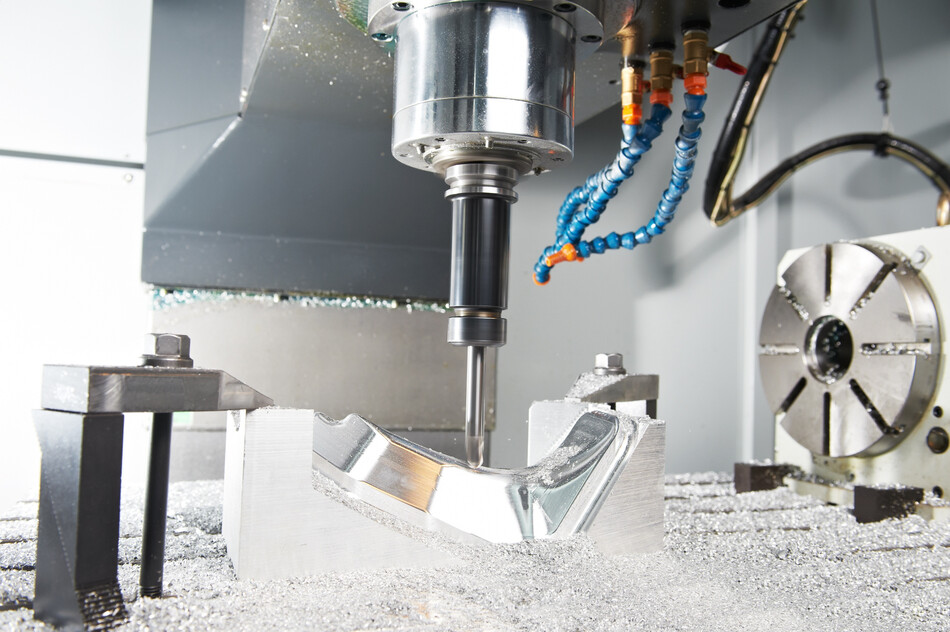ในช่วงไม่กี่ปีที่ผ่านมา คนงานและแรงงานทักษะในอุตสาหกรรมการผลิตมีจำนวนลดลงอย่างต่อเนื่อง นอกจากนี้ ยังมีความต้องการหาวิธีการผลิตใหม่ๆ ที่ให้ความเที่ยงตรงสูง โดยไม่ต้องคอยปรับตั้งกระบวนการผลิตบ่อยๆ ซึ่งจากเหตุผลเหล่านี้ อุตสาหกรรมการผลิตจึงได้มีการเปลี่ยนจากการทำงานแยกประเภทแบบเดิมมาเป็นวิธีการทำงานแบบควบรวมทุกขั้นตอนโดยใช้เครื่องกลึงกัดอเนกประสงค์ 5 แกน เพื่อลดระยะเวลาที่ใช้ในการผลิต เพิ่มความหลากหลายในการผลิตชิ้นงานประเภทต่างๆ และลดจำนวนของสายการผลิตโดยการลดจำนวนเครื่องจักรที่ใช้ (รูปที่ 1)
บทความนี้ MEGA Tech มีตัวอย่างของเทคโนโลยีที่ล้ำสมัยรูปแบบต่างๆจาก Okuma ที่จะช่วยควบรวมขั้นตอนการผลิตและใช้ประโยชน์จากระบบออโตเมชั่นของเครื่องกลึงกัด 5 แกนของเรา
เทคโนโลยีควบรวมกระบวนการผลิต

เทคโนโลยีตัดเฉือนเฟือง

เครื่องกลึงกัด 5 แกนของ OKUMA ที่มีระบบกลึงจะมาพร้อม “แพ็คเกจตัดเฉือนเฟือง” ซึ่งช่วยให้สามารถทำงานตัดเฉือนเฟืองได้โดยใช้วิธีการปอกผิวงาน (Power Skiving) และการกัดร่องเฟือง (Hobbing) โดยให้ระดับความเที่ยงตรงเทียบเท่ากับเครื่องจักรสำหรับผลิตเฟืองโดยเฉพาะ การตัดเฉือนเฟืองโดยใช้วิธีปอกผิวงานด้วยเครื่องแมชชีนนิ่งเซ็นเตอร์ 5 แกน รุ่น MU-4000V-L (รูปที่ 2) จะหมุนแบ่งองศาในแกน B (โต๊ะงานแบบทรันเนียน) และมีการควบคุมแกน C (โต๊ะงานกลม) และสปินเดิลเครื่องมือควบคู่กันเพื่อตัดเฉือนเฟืองโดยใช้หัวกัดเฉพาะทางสำหรับผลิตเฟือง ในตัวอย่างนี้ นอกจากการตัดเฉือนเฟืองแล้ว ยังสามารถทำงานประเภทอื่นๆ ได้ เช่น กลึง กัด และเจาะ โดยใช้การปรับตั้งเครื่องจักรเพียงครั้งเดียว
เทคโนโลยีการวัด
◆ ฟังก์ชั่นวัดรูปทรง 3 มิติระหว่างการตัดเฉือน “NC Gauging”
การวัดรูปทรงชิ้นงานขนาดใหญ่นอกเครื่องจักรเป็นงานที่สิ้นเปลืองเวลามาก เช่น ต้องมีการนำชิ้นงานออกจากเครื่องและเคลื่อนย้ายชิ้นงานไปยังสถานีตรวจวัด ฟังก์ชั่น “NC Gauging” เป็นฟังก์ชั่นที่ใช้สำหรับวัดรูปทรง 3 มิติได้โดยตรงที่เครื่องจักร โดยไม่จำเป็นต้องนำชิ้นงานออกจากเครื่อง รวมทั้งยังสามารถสร้างโปรแกรมวัดได้อย่างสะดวก นอกจากจะสามารถวัดได้ทั้งเส้นผ่านศูนย์กลางและมิติตามแนวยาวของชิ้นงานได้แล้ว ฟังก์ชั่นนี้ยังรองรับการวัดทางเรขาคณิตความเที่ยงตรงสูงรูปแบบต่างๆ เช่น ความกลมและความตรง ด้วยเช่นกัน
◆ ฟังก์ชั่นวัดมิติที่เฟืองโดยตรง “NC Gear Measurement”

ฟังก์ชั่น “NC Gear Measurement” ใช้สำหรับวัดมิติของเฟือง เช่น รูปทรงฟัน รูปทรงขอบฟัน ระยะพิทช์ ความเบี่ยงเบนหนีศูนย์ เป็นต้น ได้โดยตรงโดยไม่ต้องนำชิ้นงานออกจากเครื่องจักร ทำให้สามารถระบุความแม่นยำของเฟืองได้ทันทีหลังจากตัดเฉือนเสร็จ โดยการป้อนข้อมูลของจุดวัดจากข้อมูลจำเพาะของเฟืองในคอมพิวเตอร์ แล้วทำการวัดด้วยฟังก์ชั่น NC Gauging (รูปที่ 3)
Turning Cut

ฟังก์ชั่นนี้ช่วยให้สามารถควบรวมกระบวนการทำงาน เช่น การตัดเฉือนเพลาเอียงโดยการกลึงส่วนของชิ้นงานที่เป็นทรงกระบอก ซึ่งไม่ได้อยู่บนแกนกึ่งกลางของสปินเดิลหลัก ฟังก์ชั่นนี้มีประโยชน์เนื่องจากพื้นผิวซีลและร่องซีลจะสัมผัสกันแน่นหนามากขึ้นเมื่อใช้การกลึงแทนการกัดด้วยดอกเอ็นมิล สำหรับฟังก์ชั่นนี้ ชิ้นงานจะอยู่กับที่และทำการกลึงโดยการซิงค์การเคลื่อนที่แบบวงกลมของแกนป้อน (แกน X-Y, แกน Y-Z, แกน X-Y-Z) กับมุมแบ่งของแกน M (การควบคุมตำแหน่งคมตัดเครื่องมือ) วิธีนี้ทำได้โดยใช้การเคลื่อนที่ช่วงกว้างของแกน Y และความสามารถในการตามสูง (รูปที่ 4)
การนำเทคโนโลยีเลเซอร์มาใช้
เราได้นำเสนอเทคโนโลยีควบรวมกระบวนการทำงานรูปแบบต่างๆ ไปแล้วข้างต้น อย่างไรก็ตาม วิธีการเหล่านี้อาจไม่สามารถแก้ปัญหาบางอย่างได้ ดังนั้น เราจึงได้พัฒนาเครื่องขึ้นรูปอเนกประสงค์รุ่นพิเศษอย่างซีรี่ส์ “LASER EX” ซึ่งเป็นการผสมผสานเทคโนโลยีการผลิตแบบเพิ่มเนื้อโลหะ การเคลือบผิว และการชุบแข็งความเที่ยงตรงสูงเข้าด้วยกันโดยใช้เทคโนโลยีเลเซอร์ที่ล้ำสมัย ซึ่งจะเป็นหัวใจหลักของ “นวัตกรรมการผลิต” ในยุคต่อไป เครื่องจักรรุ่นนี้ประกอบด้วยเครื่องขึ้นรูปอเนกประสงค์ซีรี่ส์ “MULTUS U LASER EX” และเครื่องแมชชีนนิ่งเซ็นเตอร์ 5 แกนซีรี่ส์ “MU-V LASER EX”
การผลิตแบบเพิ่มเนื้อโลหะ

เราได้นำวิธีการขึ้นรูปโลหะด้วยเลเซอร์ (Laser Metal Deposition หรือ LMD) มาใช้กับเทคโนโลยีการผลิตแบบเพิ่มเนื้อของเรา (รูปที่ 5) โดยสำหรับวิธี LMD นี้ ผงโลหะจะถูกพ่นออกมาพร้อมก๊าซเฉื่อย จากนั้นจะถูกหลอมเหลวและประสานเข้าด้วยกันด้วยลำแสงเลเซอร์ การผลิตแบบเพิ่มเนื้อสามารถที่จะเปลี่ยนวัสดุชิ้นงานได้อย่างสะดวก โดยการสลับและผสมผงโลหะชนิดต่างๆ เข้าด้วยกัน และสามารถใช้กับการผลิตชิ้นงานที่ประกอบด้วยวัสดุหลายชนิด รวมถึงการเคลือบ การซ่อม และการแก้งาน นอกจากนั้นแล้ว อุปกรณ์ควบคุม OSP ที่บริษัทพัฒนาขึ้นเอง นอกจากจะทำหน้าที่ควบคุมกำลังเลเซอร์และการทำงานของอุปกรณ์พ่นผงโลหะแล้ว ยังทำหน้าที่ควบคุมเส้นผ่านศูนย์กลางของเลเซอร์ได้อย่างแม่นยำตามต้องการภายในช่วง φ0.4 ถึง 8.5 มม. จึงสามารถทำงานได้หลากหลายรูปแบบ ตั้งแต่การผลิตเพิ่มเนื้อที่ต้องการคุณภาพสูงไปจนถึงการผลิตที่เน้นความประหยัด
การชุบแข็งด้วยเลเซอร์

เครื่องขึ้นรูปซีรี่ส์ LASER EX สามารถสร้างแสงเลเซอร์คุณภาพสูงได้อย่างต่อเนื่อง ดังนั้น นอกจากจะใช้ได้กับการผลิตแบบเพิ่มเนื้อแล้ว จึงยังใช้ได้กับงานชุบแข็งด้วยเลเซอร์ได้เช่นกัน โดยเป็นการยิงลำแสงเลเซอร์เพื่อเพิ่มอุณหภูมิเฉพาะจุดที่ยิงลำแสงเท่านั้น บริเวณที่ถูกให้ความร้อนจะมีอุณหภูมิสูงกว่าจุดเปลี่ยนรูป (Transformation Point) จากนั้น จะเย็นลงอย่างรวดเร็วด้วยคุณสมบัติการระบายความร้อนของตัววัสดุเอง และทำให้เกิดโครงสร้างชุบแข็งที่วัสดุ (รูปที่ 6)
Article by: MEGA Tech & Okuma Techno (Thailand) Ltd. << Click












